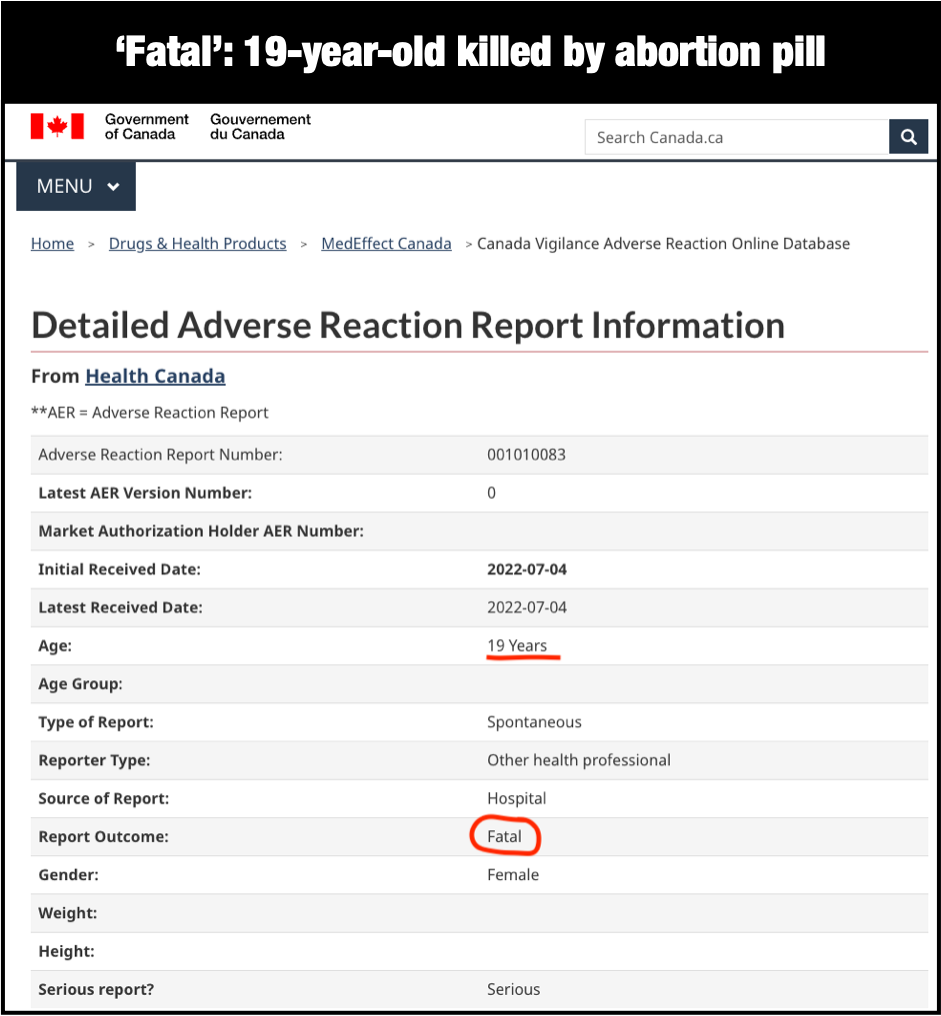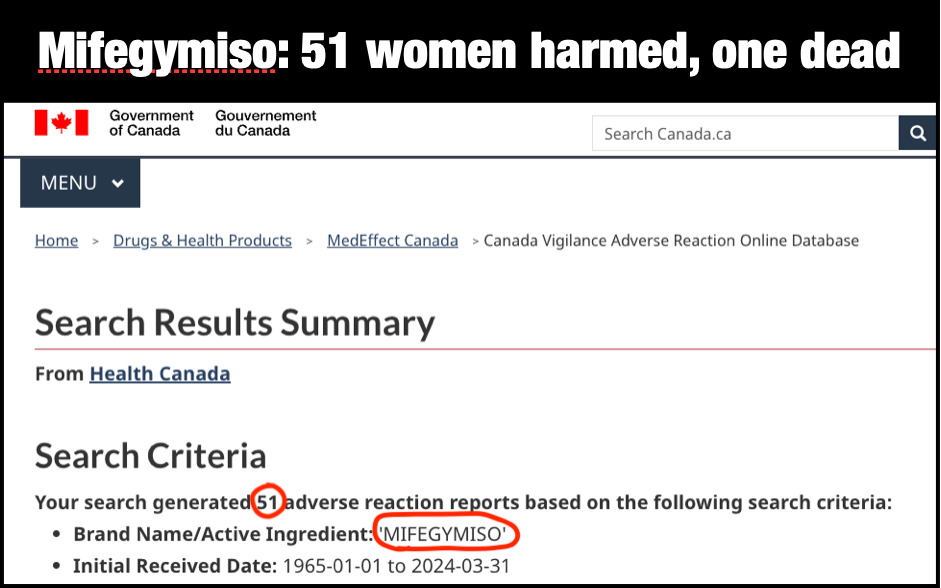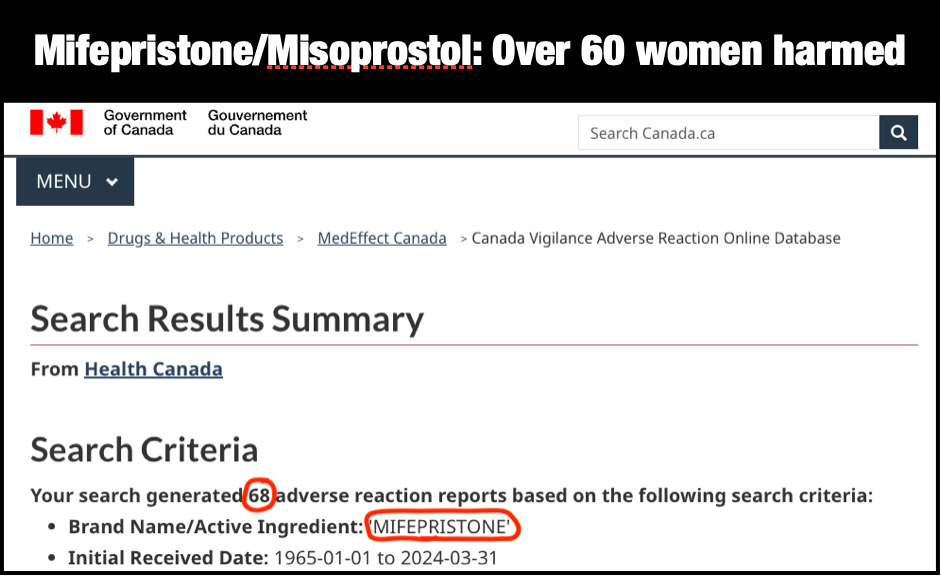(CLC) Canadian abortion activists have hailed the abortion pill as the “gold standard” method for ending the life of a preborn child, highlighting its allegedly “outstanding safety record.” But, according to the Canadian government’s website that tracks adverse reactions to drugs, over 100 Canadian women have been severely harmed by the abortion pill protocol since it first became available in Canada in 2017.
One 19-year-old, along with her baby, tragically died in the wake of using the deadly pills, according to Canada’s adverse reaction online database.
[Click here to subscribe to Pregnancy Help News!]

The “Canada Vigilance Program” is used by the government’s Department of Health to track adverse reactions, or side effects, to drugs and other health products used by Canadians. Healthcare professionals, such as doctors, voluntarily submit reports if they suspect that a drug has seriously harmed their patients.
Programs such as these act as an early warning system, allowing the government to pull a drug from the market before it harms more people. One of the most well-known recalls was Thalidomide, a German-made drug widely used in the 1950s-60s to treat nausea in pregnant women. The drug, marketed in Canada as “Kevadon,” had the devastating side effect of causing severe birth defects in children in utero. The Canadian government recalled the drug in 1962, but not until it had already caused malformations in some 100 babies.
The abortion pill protocol is marketed in Canada as “Mifegymiso.” It consists of two drugs taken at different times. The pregnant mother first takes Mifepristone orally in the form of a pill. This drug blocks the mother’s progesterone, a hormone needed to sustain the tiny new life attached to her uterine wall. Without progesterone, the mother’s pregnancy-sustaining mechanism shuts down. The new life is ended. Some 24-48 hours later, the woman orally ingests the second drug. Misoprostol initiates powerful uterine contractions that cause the woman to bleed heavily as she expels her dead baby.
As of July 2024, there have been over 100 adverse reports for the abortion pill protocol. Fifty-one are listed for the protocol branded as “Mifegymiso.” An additional 67 are listed when a search is performed for the two drugs that comprise the Mifegymiso protocol – Mifepristone and Misoprostol.

These women have suffered “serious” outcomes after using abortion pills, one dying and numerous others having near brushes with death. Adverse reactions include many side effects listed in Health Canada’s product literature for Mifegymiso. The vast majority of cases are categorized as “serious,” meaning that the abortion pills' effects on the women were life-threatening, and/or required hospitalization, and/or resulted in disability or permanent damage.
According to the data, Canadian women using the abortion pill protocol have experienced hemorrhaging (severe blood loss at times requiring transfusion), loss of consciousness, sepsis (the body’s extreme response to an infection that damages vital organs), septic shock resulting in death, and thrombosis (blood clots in the circulatory system), to name a few.
Tweet This: Canadian women using the abortion pill have had hemorrhaging, loss of consciousness, sepsis, septic shock resulting in death, and thrombosis
One Canadian woman (001092713), age unknown, experienced a near-death ordeal in a situation that critics of abortion pills previously predicted. Critics warned that allowing the abortion pill to be given to women without any medical supervision would inevitably result in a woman with an undiagnosed ectopic pregnancy using the pills – to her harm.

The makers of the abortion pill protocol strictly warn that the product is not to be used if there is suspicion of an ectopic pregnancy where the new life implants outside the womb. “Prior to prescribing Mifegymiso, health professionals must…exclude ectopic pregnancy,” states the product literature. This happens typically by way of ultrasound. The possibility of an ectopic pregnancy must be excluded since the abortion pill cannot expel the new life growing outside the woman’s womb in her fallopian tube.
The new life growing in the tube eventually causes the tube to expand and rupture. The ruptured tube is deadly to the mother. The problem, as explained by the product literature, is that the woman with an ectopic pregnancy may mistake her ruptured tube for the effects of the abortion pills. “Some of the symptoms of a medical abortion may be similar to those of a ruptured ectopic pregnancy,” the literature states.
The woman mentioned above experienced “Ruptured ectopic pregnancy” along with “pain” in a report that listed the outcome as “serious.”

In 2019, Health Canada recklessly put women’s lives at risk by removing the ultrasound requirement to prescribe the drug.
The most recent data dump of women harmed by the abortion pill protocol is from March of this year. A total of 36 reports were submitted in that month. This is a huge spike when compared to previous years. In 2023, there were nine reports in total for the abortion protocol submitted (data retrieved for Mifegymiso and Mifepristone/Misoprostol). In 2022, 8. In 2021, 3. In 2020, 45. The 36 reports in 2024, when compared to the average number of reports since 2017 (which is 11), represent a staggering 227% increase.
The evidence is clear: Canadian women are being harmed by the chemical abortion protocol. The “Canada Vigilance Program” is working and showing that there is significant harm being caused to women to justify pulling this protocol from the market. One woman dead and over a hundred seriously injured is already far too many. And these numbers are likely only the tip of the iceberg, given that the adverse reaction program is voluntary and an unknown number of cases go unreported.
Tweet This: The evidence is clear: Canadian women are being harmed by the chemical abortion protocol.
It’s time to pull Mifegymiso and the Mifepristone/Misoprostol abortion protocol off the market. Canadian women’s lives matter. How many more women will be seriously harmed and even killed before Health Canada acknowledges the data and decides to act?
Abortion activists like to refer to the abortion pill protocol as “medicine.” But medicine is meant to cure an illness or disease. Pregnancy is not a disease. The abortion pill protocol is, therefore, not medicine but deadly drugs that are intended to end the life of preborn humans. The protocol can sometimes be fatal to the mother, too.
Tweet This: Pregnancy is not a disease. The abortion pill is thus not medicine, but deadly drugs that are intended to end the life of preborn humans.
Canada needs to return to valuing all human life. It must become a leader in human rights by banning drugs that are aimed at ending the lives of smaller and more vulnerable humans – namely, those who are preborn. It must ban drugs that are causing severe harm to mothers. Preborn children’s lives are on the line. Mothers’ lives are on the line. Health Canada must act to ban this drug.
Please sign our petition demanding that Health Canada ban the abortion pill. Click here to sign.
Editor's note: This article was published by Campaign Life Coalition and is reprinted with permission.






